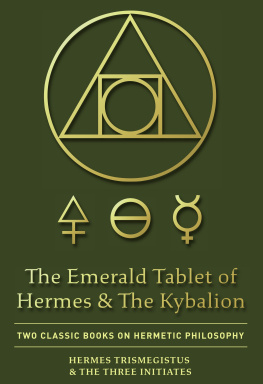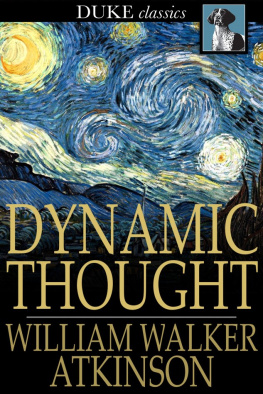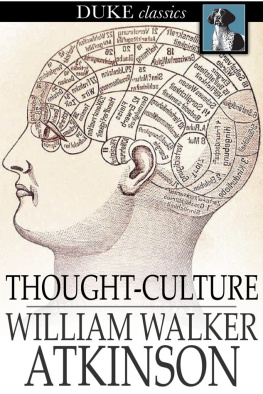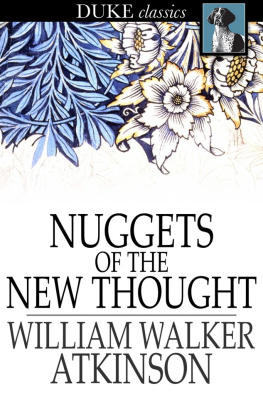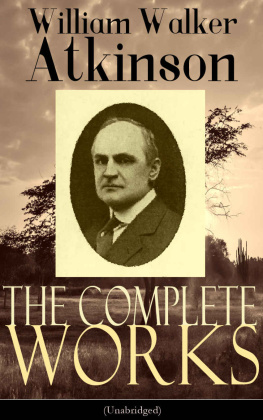Hermes Trismegistus - The Emerald Tablet Of Hermes & The Kybalion: Two Classic Books on Hermetic Philosophy
Here you can read online Hermes Trismegistus - The Emerald Tablet Of Hermes & The Kybalion: Two Classic Books on Hermetic Philosophy full text of the book (entire story) in english for free. Download pdf and epub, get meaning, cover and reviews about this ebook. year: 2020, publisher: Mockingbird Press LLC, genre: Religion. Description of the work, (preface) as well as reviews are available. Best literature library LitArk.com created for fans of good reading and offers a wide selection of genres:
Romance novel
Science fiction
Adventure
Detective
Science
History
Home and family
Prose
Art
Politics
Computer
Non-fiction
Religion
Business
Children
Humor
Choose a favorite category and find really read worthwhile books. Enjoy immersion in the world of imagination, feel the emotions of the characters or learn something new for yourself, make an fascinating discovery.
- Book:The Emerald Tablet Of Hermes & The Kybalion: Two Classic Books on Hermetic Philosophy
- Author:
- Publisher:Mockingbird Press LLC
- Genre:
- Year:2020
- Rating:5 / 5
- Favourites:Add to favourites
- Your mark:
The Emerald Tablet Of Hermes & The Kybalion: Two Classic Books on Hermetic Philosophy: summary, description and annotation
We offer to read an annotation, description, summary or preface (depends on what the author of the book "The Emerald Tablet Of Hermes & The Kybalion: Two Classic Books on Hermetic Philosophy" wrote himself). If you haven't found the necessary information about the book — write in the comments, we will try to find it.
The Kybalion was first published anonymously in 1908 by The Three Initiates. The true authorship of the work is unknown, although theories suggest it was written entirely or in part by William Walker Atkinson.
Atkinson was a prolific writer and supported the New Thought movement of the 19th and early 20th centuries. New Thought included the belief that our realities can be manifested by mental effort, which is also suggested in Hermetic principles. Scholars point to similarities in style and content between The Kybalion and Atkinsons own The Arcane Teachings as evidence that he was one (or all) of The Three Initiates.
The Kybalion provides an introduction to the teachings of Hermes Trismegistus-Hermes the Thrice-Greatest. This Master of Masters is said in The Kybalion to have lived 300 years on Earth, and believed by some to be the founder of both astrology and alchemy (precursors to astronomy and chemistry, respectively). Hermes Trismegistus was deified after his death as Toth by the ancient Egyptians, and Hermes by the Greeks. In both pantheons, this man-turned-god was considered a symbol of great wisdom.
The Kybalions explanation of Hermetic teachings are claimed to have been passed down orally for centuries, eventually reaching The Three Initiates. The fundamental Hermetic traditions presented in The Kybalion consist of seven working principles: Mentalism, Correspondence, Vibration, Polarity, Rhythm, Cause and Effect, and Gender. Within these seven principles is true wisdom, tied to no particular place and no particular religion. It is the sacred flame kept lit by a chosen few used to re-light the lesser lamps of the outside world when the light of truth grew dim... In short, these are the truths of the universe, regardless of era or creed.
The Emerald Tablet of Hermes is a short, ancient text attributed to Hermes Trismegistus himself. Unlike The Kybalion, which aims to provide some explanation and instruction, the brief Emerald Tablet has been puzzling and fascinating scholars for over 1,000-years.
Consisting of a mere 14 stanzas, the Emerald Tablet is said to contain the secrets of prima material, the foundational material of the universe. The Emerald Tablet and its teaching influenced freemasonry and philosophy throughout history. The text of the tablet has been translated and commented on by a variety of scholars, including Sir Isaac Newton who was inspired by its teachings throughout his life and work.
The earliest known version of the text comes from an Arabic work written between the 6th and 8th centuries by Balinas. He claimed to have found the tablet hidden in a vault beneath a statue of Hermes. Another story claims the tablet was written by Seth, the third son of Adam and Eve. And yet, another says the tablet was uncovered and then reburied by Alexander the Great.
The source and material of the physical tablet is unknown. It was reported to be a rectangular green stone, with text in raised bas-relief rather than engraved. Some even claim there never was a physical tablet at all, although several accounts claim it was on display in Egypt in 330 BCE. Whatever its origins and history, the work was first introduced to the West in the 12th century through Latin translations. Since then, this cryptic text has been translated and re-translated, pored-over and analyzed by philosophers, historians, and theologians alike.
Hermes Trismegistus: author's other books
Who wrote The Emerald Tablet Of Hermes & The Kybalion: Two Classic Books on Hermetic Philosophy? Find out the surname, the name of the author of the book and a list of all author's works by series.

